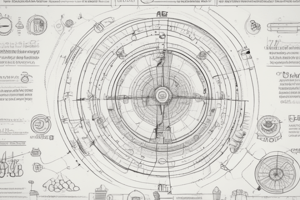Podcast
Questions and Answers
What is the purpose of self-classification in the context of designing a questionnaire?
What is the purpose of self-classification in the context of designing a questionnaire?
- To determine the effectiveness of the questionnaire
- To categorize respondents into specific groups (correct)
- To identify the needs of the respondents
- To enhance the validity of the data collected
Which data collection method does NOT typically involve direct interaction with respondents?
Which data collection method does NOT typically involve direct interaction with respondents?
- Face-to-face interviews
- Web/online surveys
- Mailed questionnaires (correct)
- Group discussions
What characteristic is essential to consider when determining the audience for a questionnaire?
What characteristic is essential to consider when determining the audience for a questionnaire?
- The number of respondents
- The language used in the questionnaire
- The educational background of respondents
- Pre-existing knowledge about the issue (correct)
What does choosing an anonymous data collection procedure imply?
What does choosing an anonymous data collection procedure imply?
Why is it important to consider the characteristics of the audience when designing a questionnaire?
Why is it important to consider the characteristics of the audience when designing a questionnaire?
What is one of the key aspects of confidentiality regarding respondent data in research?
What is one of the key aspects of confidentiality regarding respondent data in research?
Which method is NOT mentioned as a means to conduct data collection?
Which method is NOT mentioned as a means to conduct data collection?
When designing a questionnaire, which type of question allows for a broader range of responses?
When designing a questionnaire, which type of question allows for a broader range of responses?
How should the components of the questionnaire be structured?
How should the components of the questionnaire be structured?
Which of the following accurately describes predetermined answers in a questionnaire?
Which of the following accurately describes predetermined answers in a questionnaire?
What is the primary purpose of a questionnaire?
What is the primary purpose of a questionnaire?
Which of the following best describes 'attitude' as outlined in the content?
Which of the following best describes 'attitude' as outlined in the content?
What is essential to determine before designing a questionnaire?
What is essential to determine before designing a questionnaire?
In the context of a questionnaire, what does 'knowledge' refer to?
In the context of a questionnaire, what does 'knowledge' refer to?
Which component is NOT necessary for developing a questionnaire?
Which component is NOT necessary for developing a questionnaire?
What does the term 'behavior/practice' imply in the context of questionnaire design?
What does the term 'behavior/practice' imply in the context of questionnaire design?
What should be prioritized when creating survey questions?
What should be prioritized when creating survey questions?
Which term describes aspirations that require imagination and understanding?
Which term describes aspirations that require imagination and understanding?
Flashcards are hidden until you start studying
Study Notes
Questionnaire Definition
- A questionnaire is a tool to gather information from individuals about their feelings, beliefs, experiences, perceptions, or attitudes.
- It is a written or printed form consisting of a list of questions.
- It is an efficient way to collect data from a large number of individuals.
Questionnaire Design Steps
-
Determine purpose: What are you trying to find out? What research question are you trying to answer?
-
Decide what to measure:
- Attitude: A person's mental and emotional response to something.
- Knowledge: A person's understanding of a subject.
- Vision/Dream: A person's aspirations and understanding of a particular issue.
- Behavior/Practice: A person's actions and mannerisms in response to their environment.
- Self-classification: How a person identifies themselves.
- Characteristics: Features or qualities that describe a person, place, or thing.
-
Determine who should be asked: Who is your target audience?
-
Consider the audience: Understand their level of knowledge, experience, and approach to the topic.
Questionnaire Design Considerations
-
Choose data collection method:
- Mailed: Questionnaire sent through the mail.
- Face-to-face: Delivered in person and completed on the spot.
- Web/online: Delivered and completed online.
-
Choose collection procedure:
- Anonymous: Respondent's identity is not collected.
- Confidential: Respondent's identity is collected but not published (data remains confidential).
-
Choose measurement score:
- Close-ended questions: Respondents choose from a predetermined list of answers.
- Open-ended questions: Respondents provide their own answers.
-
Create a questionnaire:
- Separated: Instructions and questions are presented on separate pages.
- Combined: Instructions and questions are presented on the same page.
Questionnaire Structure
- Instructions: Clear and concise instructions on how to complete the questionnaire.
- Predetermined answers: A list of possible responses for close-ended questions.
- Additional information: Supportive information on the object of research.
Studying That Suits You
Use AI to generate personalized quizzes and flashcards to suit your learning preferences.




